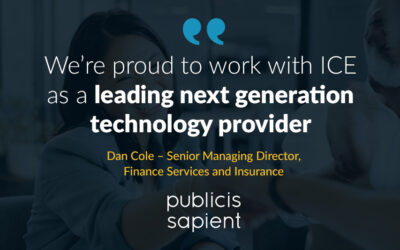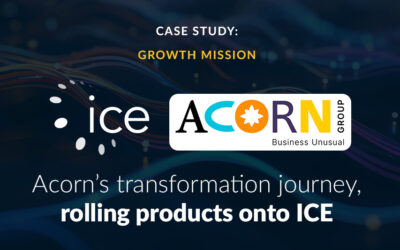Al Robertson, Chief Technology Officer at ICE InsureTech, explains the finer details of ICE’s proven technology that has led to Celent’s industry recognition of ICE Claims & ICE Policy.
At ICE, we are incredibly proud of retaining the Celent XCelent Technology Award for EMEA Claims Systems for the third report running and being able to add this to the same award for Policy Administration Systems won in January.
But what does it really mean that an Insurance platform wins the Technology Award?
Of course, people expect that platforms today run in the cloud and have a modern architecture but let’s look at some of the finer details.
We asked Al Robertson, our CTO, to help explain some of the terms and technologies and what it means to both an Insurance business as well as their IT colleagues:
Is cloud native the same as running in the cloud?
Cloud native is more than just being able to host applications in the cloud. We take our definition of Cloud Native from the Cloud Native Computing Foundation (CNCF) https://www.cncf.io/
Cloud native application development is an approach to building and running an application that can take full advantage of the cloud computing model based on four key tenets:
- Architecture – Service Based
- Communication – API Driven
- Infrastructure – Containers/Packaged Applications/Container Orchestration
- Process – DevOps
The benefits of cloud native application development include delivery of value at pace, superior customer experience, improved reliability, ease of management, on-demand and efficient use of infrastructure (reduced costs), automation and observability.
ICE have been running applications in the cloud for many years, but we have been cloud native since 2017.
What are microservices and why are they important? Why are APIs so significant?
Traditionally, applications have been delivered as a large monolith. Microservices are the decomposition of functional domains into smaller architectural components. Smaller components have the advantage of being more agile; independently developed, independently deployable and quickly scalable when peak traffic demands it.
We’ve taken the architectural decision to introduce microservices where required to efficiently support the varying load that web scale requires, but we do not currently see the advantage of introducing microservices everywhere.
All communication between components is via APIs. We have an Open Business API Gateway to support connected platforms, usually Digital Portals and Apps. ICE APIs are configuration driven and self-documenting. The ICE Policy APIs support the full insurance policy lifecycle, including Price Comparison Website quotations. The ICE Claims APIs support eFNOL and connected portals for claimants and work providers. ICE has thousands of private APIs behind the gateway that help deliver a secure, resilient, performant and observable distributed architecture.
What does event driven mean? Is this just workflow?
ICE has an event-driven architecture that generates 150+ event messages as they occur. Our configurable event framework supports asynchronous processing of each of the events generated. An example would be to create a simple audit log, or to notify downstream systems of updates in the transacting platform, e.g. General Ledger, Underwriter bordereaux, MI etc.
Workflow, or business process orchestration, allows customers to tailor their processes, automation and tasks. An example would be to resubmit a failed payment and notify a customer, to generate and send correspondence, or to call an external enrichment/AI/ML service, etc.
ICE’s event-driven architecture is complementary with our business process orchestration capability, catering for any bespoke processing a client may want to inject into a process.
Applications have been integrating to other applications and data sources for years – what is the modern way to do this and why does it benefit the Insurance industry?”
ICE has two primary integration capabilities:
- To provide integration “plug-ins” to enrich the ICE Ecosystem with outbound calls to third party data sources or to output data for third party systems to consume. We achieve this through our Enterprise Service Bus (ESB) technology.
- To provide an Enterprise API Gateway capability for third party applications, usually Digital Portals to consume ICE services.
There has always been the requirement for Policy and Claims Administration Systems to integrate with external systems, but there is now an industry expectation to be able to integrate with the current wave of Insurtechs that solve niche problems better than most core platforms. Having an Open platform, architected to allow each client to make their own integration choices is the key to success and longevity.
What are the benefits of using The ICE Cloud? Is data secure in a public cloud?
The ICE Cloud is a public cloud hosted Managed Application Service (MAS) for our clients. The current platform takes advantage of AWS infrastructure but has the ability to run in other public clouds (e.g. Azure/GCP) if required.
The ICE Cloud uses many CNCF components to deliver a Next Generation Operational Platform for our clients:
- Container Orchestration: Kubernetes-based
- Service Mesh: Istio, Kiali
- Time Series monitoring and visualisation: Prometheus & Grafana
- Distributed Tracing: Jaeger
- Logging: Fluentd, ELK stack
This platform includes support for High Availability (HA) configuration spanning three data centres and provides detailed telemetry, monitoring, alerting, auto scaling and self-healing. This offers a resilient and reliable cloud-based service to our clients, that can be quickly established, without the need for clients to have specific expertise in the technologies involved.
Security, especially with the accelerated move to public cloud, is consistently one of the highest priorities for us and our clients. Building upon the security of the global infrastructure provided by public cloud; ICE Cloud incorporates various levels of additional security at network, operating system and application level in combination with best of breed tooling and testing to ensure the security of client workloads. The flexible architecture of ICE Cloud allows full segregation between client’s data and control over data residency enabling ICE to meet all customer compliance requirements.
Conclusion
We hope our explanations deliver context to what it really means for an Insurance platform to receive accreditation for proven and advanced technology, as well as the business benefits such technology brings to our clients.
Celent’s industry recognition of ICE Claims and ICE Policy echoes our continuous innovation, capability and our proven technology ahead of all of our leading competitors.
ICE InsureTech guarantees innovation, choice, and digital transformation.
Al Robertson, Chief Technology Officer
ICE InsureTech
More articles
The Power of ICE and Publicis Sapient
Imagine real-time, up-to-the-minute customer data – unlocking new opportunities and driving real change. That’s why we’ve partnered with Publicis Sapient, combining our strengths to offer insurers large-scale implementations in weeks, not years.
New Case Study: The Acorn Group’s Growth Mission with ICE
Acorn Group wanted to embark on a transformative journey to support its growth strategy as they scale as a business. ICE Policy has empowered them with a platform that enables Acorn to independently roll products onto ICE.
From Trainee Underwriter to CEO: Andrew Passfield’s journey to becoming ICE’s CEO
The latest Beyond the Desk Podcast episode is out! Our CEO, Andrew, joins Mark Thomas to share his incredible journey, from entering the insurance industry with no IT background, to leading an award-winning insurance software company experiencing significant growth....




